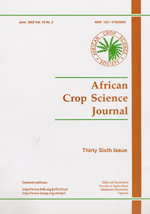
|
African Crop Science Journal
African Crop Science Society
ISSN: 1021-9730
EISSN: 1021-9730
Vol. 20, No. 1, 2012, pp. 59-66
|
 Bioline Code: cs12006
Bioline Code: cs12006
Full paper language: English
Document type: Research Article
Document available free of charge
|
|
|
African Crop Science Journal, Vol. 20, No. 1, 2012, pp. 59-66
| fr |
Badii, K.B. & Asante, S.K.
Résumé
Les chenilles constituent une contrainte majeur à l’augmentation et à la production durable du coton dans l’écologie de la savane du Ghana. Des études étaient menées en Fermes Expérimentales de l’Université pour Etudes Développementales, Nyankpala au Nord du Ghana, durant la saison pluvieuse 2009, pour évaluer les effets de trois formulations d’ insecticides communément utilisées, à savoir, Betsulfan et Endosulfan (chacun à 3.2, 3.5 et 3.9 l ha-1), ainsi que Thionex (à 2.3, 2.5 et 2.8 l ha-1) sur la densité de populationon et l’incidence de dommage du complexe de chenille, et leurs effets sur le rendement du coton. L’incidence et l’abondance des chenilles étaient significativement (P<0.05) affectées par les différents traitements d’insécticides. L’infestation de la chenille dans toutes les parcelles traitées avec insecticides était significativement réduite. Parmi les traitements d’insecticides, Thionex à 2.8 l ha-1 était le plus efficace. suivi par les traitements de Betsulfan (3.9 l ha-1), Betsulfan ou Endosulfan (chacun à 3.2 l ha-1) avec une infestation la plus élevée. Le rendement en fibre du coton a aussi augmenté significativement avec l’augmentation des concentrations des insecticides. Le Thionex (2.8 l ha-1) avait induit des rendements les plus élevés pendant que les parcelles avec Betsulfan (3.2 l ha-1) avient produit des rendements les plus basses. Afin de mieux contrôler les chenilles du coton pour un rendement maximum dans lécologie, le Thionex appliqué à 2.8l ha-1 est le plus recommendé.
Mots Clés
Contrôle, chenille du coton, efficacité, Ghana, insecticides synthétiques
|
| |
| en |
Efficacy of some synthetic insecticides for control of cotton bollworms in northern Ghana
Badii, K.B. & Asante, S.K.
Abstract
Lepidopteran bollworms are a major constraint to increased and sustainable production of cotton in the savanna ecology of Ghana. Studies were conducted at the Experimental Farms of the University for Development Studies, Nyankpala in northern Ghana, during the 2009 cropping season to evaluate the effects of three commonly used insecticide formulations, namely, Betsulfan and Endosulfan (each at 3.2, 3.5 and 3.9 l ha-1), and Thionex (at 2.3, 2.5 and 2.8 l ha-1), on the population density and damage incidence of the bollworm complex, and their effects on the yield of cotton. The incidence and abundance of bollworms were significantly (P < 0.05) affected by the different insecticide treatments. Bollworm infestation in all treated plots was significantly reduced. Among the insecticide treatments, Thionex at 2.8 l ha-1 was the most effective. This was followed by that of Betsulfan at 3.9 l ha-1, Betsulfan or Endosulfan (each at 3.2 l ha-1) recorded the highest infestation. Lint seed yield of cotton also increased significantly with increased concentrations of the insecticides, Thionex at 2.8 l ha-1 and Betsulfan at 3.2 l ha-1 recorded the highest and lowest yields, respectively. For effective control of cotton bollworms for maximum yield in the ecology, Thionex applied at 2.8 l ha-1 is recommended.
Keywords
Control, cotton bollworms, efficacy, Ghana, synthetic insecticides
|
| |
© Copyright 2012 - African Crop Science Society
|
|
